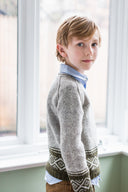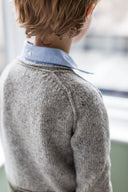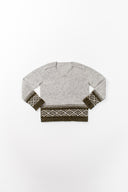Carson
Pattern Specs
CONSTRUCTION
- Body and sleeves are worked in the round from the bottom to the underarm. The front, back, and sleeve caps are worked flat, then sewn together.
FINISHED DIMENSIONS
- 23¼ (24¾, 26, 28¾, 31¼)” circumference at chest Sized for 2 (4, 6, 8, 10) years
- Sample shown is size 6 (26″) shown on child who normally wears size 6 Shown in fourth and fifth photos on child who normally wears size 5
Need help picking a size? See our resource page on Selecting a Sweater Size 101.
GAUGE
- 24 stitches & 38 rows/rounds = 4″ in stockinette stitch with Size A needle(s), after blocking
- 24 stitches & 34 rounds = 4″ in charted colorwork pattern with Size B needle(s), after blocking
- 17-round motif from Chart measures 2″ tall with Size B needle(s), after blocking
NEEDLES
Size A (for Main Fabric):
- One each 16″ and 24″ circular needles and one set of double-pointed needles (DPNs)* in size needed to obtain gauge listed
- Suggested Size: 3½ mm (US 4)
Size B (for Charted Colorwork Sections):
- One 24″ circular needle and one set of DPNs*, one size larger than Size A
- Suggested Size: 3¾ mm (US 5)
Due to significant variance between knitters, your colorwork fabric should be swatched prior to knitting your sweater to determine whether or not this needle size should be larger, smaller or equal to Size A.
Size C (for Tubular Cast On and Ribbing):
- One 16″ or 24″ circular needle (use 16” circular for 3 smallest sizes) and one set of DPNs*, one size smaller than Size A
- Suggested Size: 3¼ mm (US 3)
*32” circular needle can be used instead of DPNs if using the Magic Loop method for working small circumferences in the round (i.e. Sleeves).
Note: If you have adjusted the needle size to obtain the correct gauge, it may or may not be necessary to make a matching adjustment to the needle size used for Tubular Cast On due to variance in individual work. Please test your chosen cast-on method on your swatch.
Please note: the stitch patterns in this garment are charted only.
Pattern Materials
YARDAGE
Fingering weight wool yarn in the following approximate amounts:
- 415 (500, 585, 710, 810) yards Color 1 (C1)
- 150 (155, 165, 180, 190) yards Color 2 (C2)
YARN
- 2 (2, 3, 3, 3) skeins Color 1 and 1 skein Color 2 of Brooklyn Tweed Loft (100% American Targhee-Columbia wool; 275 yards/50g)
- Photographed in colors Snowbound (C1) and Artifact (C2)
Techniques
Tutorials for all special techniques listed below are included in the pattern
- Sloped Bind Off
- Sewn Bind Off (Elizabeth Zimmermann’s method)
- Tubular Cast On (for 2×2 ribbed fabric)
- Grafting (Kitchener Stitch)
Errata
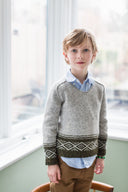
Carson
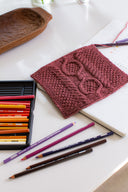
Uncompromising Excellence in Every Detail

